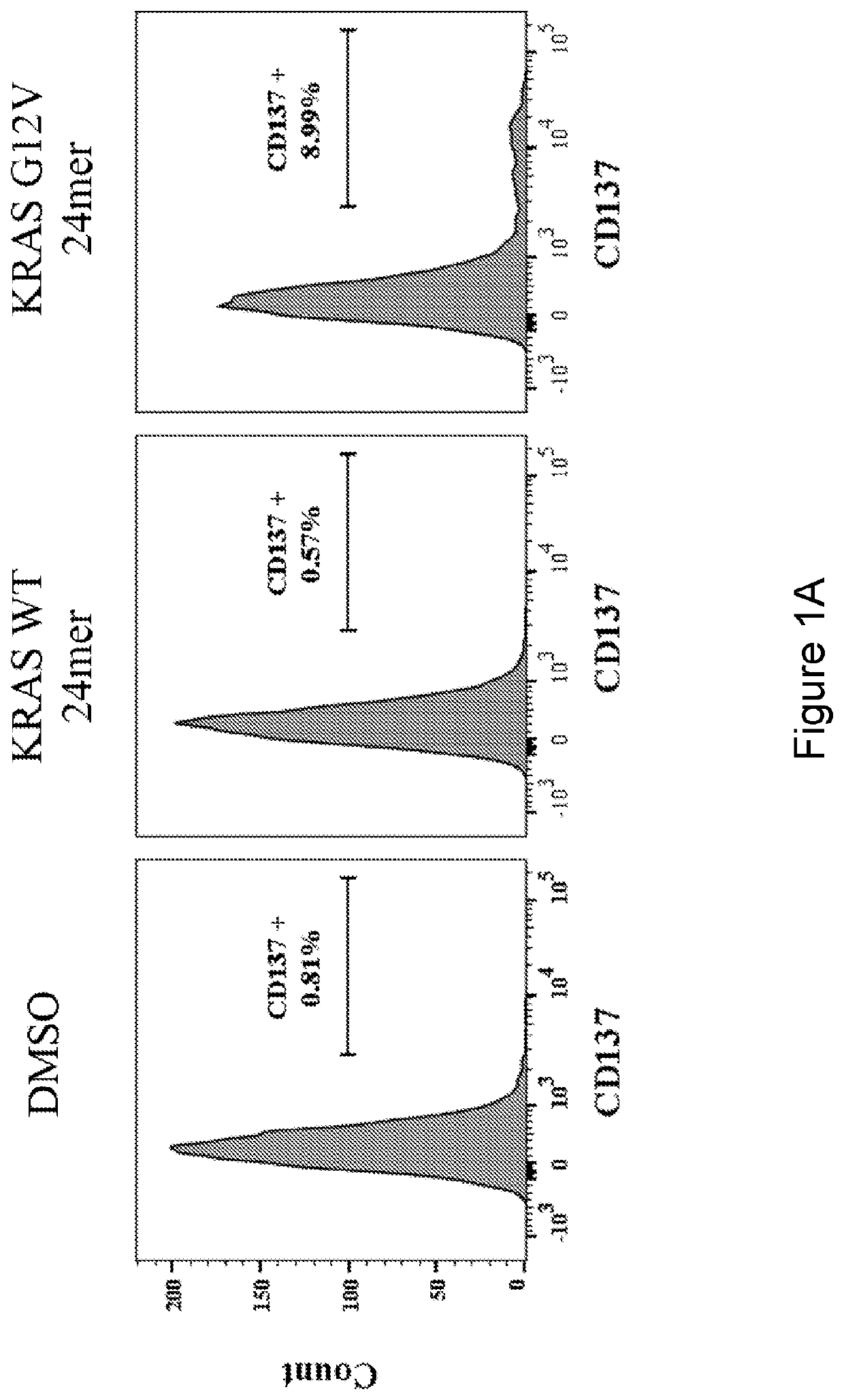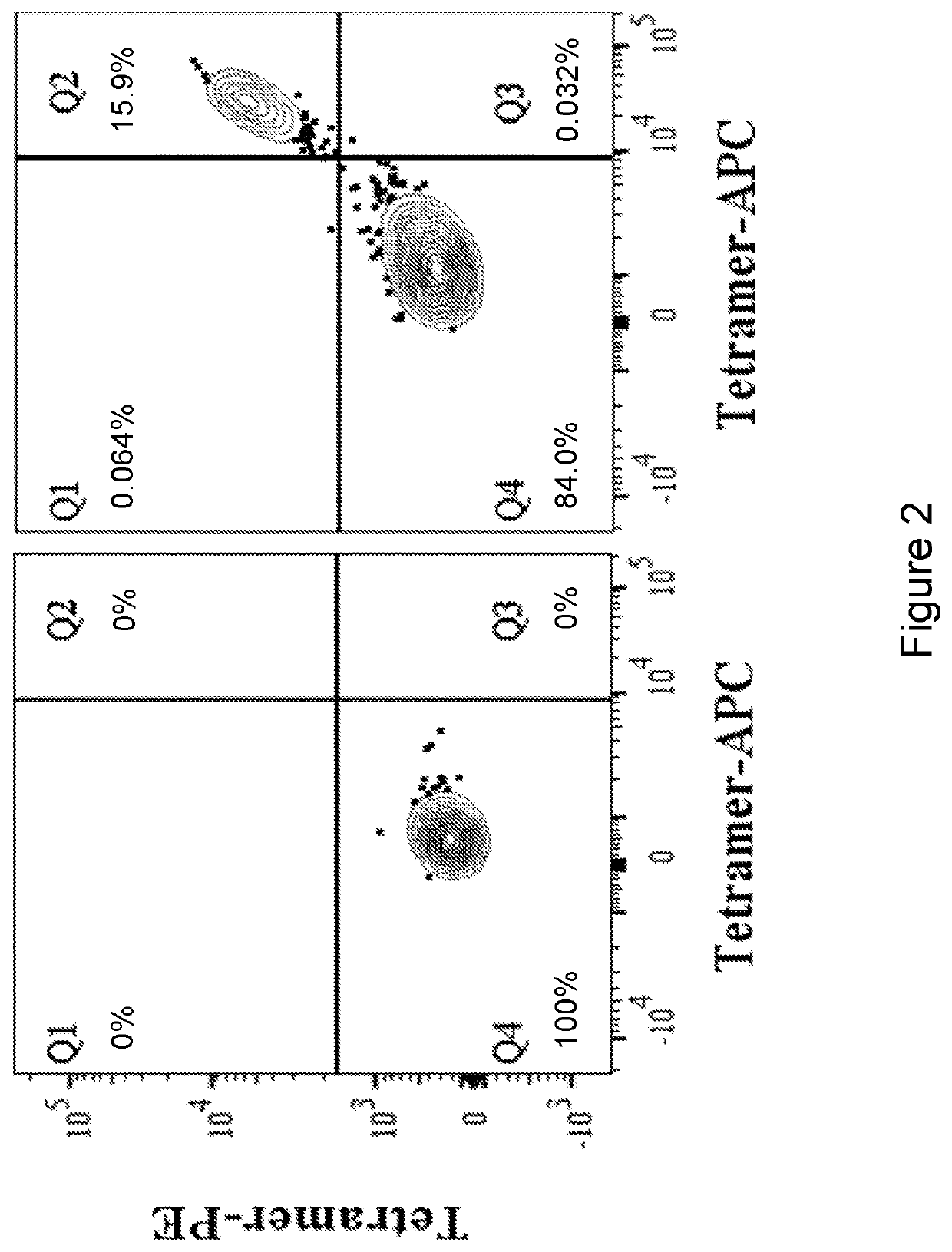HLA class I-restricted t cell receptors against mutated RAS
a t cell receptor and restriction technology, applied in the field of tcell receptor isolation or purification, can solve the problems of poor prognosis of many cancers, limited treatment options for cancers, and poor prognosis for many cancers, such as pancreatic, colorectal, ovarian, prostate cancer,
- Summary
- Abstract
- Description
- Claims
- Application Information
AI Technical Summary
Benefits of technology
Problems solved by technology
Method used
Image
Examples
example 1
[0124]This example demonstrates the isolation of a TCR having antigenic specificity for human KRAS with the G12V mutation, wherein the mutated KRAS is presented by an HLA-A*11:01 molecule.
[0125]The TCR was identified and isolated from an endometrial cancer patient's peripheral blood following in-vitro sensitization (IVS). The patient's cancer cells were found to be expressing the KRAS G12V mutation. Briefly, autologous DCs were pulsed with a mutated peptide (MTEYKLVVVGAVGVGKSALTIQLI) (SEQ ID NO: 26) and co-cultured for 10 days with CD8 T cells sorted from the patient's peripheral blood.
[0126]Next, the reactivity of the T cells was tested against autologous DCs pulsed with a 24-mer peptide encompassing the KRAS G12V mutation (MTEYKLVVVGAVGVGKSALTIQLI) (SEQ ID NO: 26) or the corresponding WT peptide (MTEYKLVVVGAGGVGKSALTIQLI) (SEQ ID NO: 27). The peptides are resuspended in DMSO. T cells cultured with DCs pulsed with DMSO was used as a negative control. T cell reactivity was measured ...
example 2
[0130]This example demonstrates the preparation of an expression cassette encoding the TCR of Example 1 with a cysteine-substituted, LVL-modified murine constant region and the cloning of the expression cassette into a retroviral vector.
[0131]The TCR of Example 1 was cloned into a MSGV1-retroviral vector. A nucleic acid sequence encoding the isolated G12V-reactive TCR of Example 1 (comprising the nucleotide sequences of SEQ ID NO: 31 and SEQ ID NO: 32) and including a cysteine substituted, LVL-modified murine constant region was cloned into the retroviral vector. The α chain murine constant region comprised the amino acid sequence of SEQ ID NO: 17 wherein X at position 48 is Cys, X at position 112 is Leu, X at position 114 is Ile, and X at position 115 is Val. The β chain constant region comprised the amino acid sequence of SEQ ID NO: 18, wherein X at position 57 is Cys. A P2A linker comprising the amino acid sequence of SEQ ID NO: 25 (Wargo et al., Cancer Immunol. Immunother., 58(3...
example 3
[0132]This example demonstrates that peripheral blood allogeneic T cells transduced with the TCR of Example 2 specifically recognize human KRAS with the G12V mutation, wherein the mutated KRAS is presented by an HLA-A*11:01 molecule.
[0133]Retrovirus encoding the TCR of Example 2 was made and used to transduce peripheral blood allogeneic T cells from two donors (methods as described in Tran et al., N. Engl. J. Med., 375: 2255-2262 (2016)). Expression of the TCR on the surface of the cells was measured by flow cytometry. The results are shown in FIG. 3. As shown in FIG. 3, murine TCR beta chain constant region (mTCRbeta) expression was detected on the surface of the cells.
[0134]The allogeneic cells transduced with the TCR of Example 2 were tested for reactivity against target cancer cell lines expressing KRAS G12D, KRAS G12C, or KRAS G12V. The target cancer cell lines were positive or negative for HLA-A11 expression, as shown in FIG. 4. Reactivity was measured by IFN-γ production (ELI...
PUM
| Property | Measurement | Unit |
|---|---|---|
| concentrations | aaaaa | aaaaa |
| concentrations | aaaaa | aaaaa |
| concentrations | aaaaa | aaaaa |
Abstract
Description
Claims
Application Information
 Login to View More
Login to View More - R&D
- Intellectual Property
- Life Sciences
- Materials
- Tech Scout
- Unparalleled Data Quality
- Higher Quality Content
- 60% Fewer Hallucinations
Browse by: Latest US Patents, China's latest patents, Technical Efficacy Thesaurus, Application Domain, Technology Topic, Popular Technical Reports.
© 2025 PatSnap. All rights reserved.Legal|Privacy policy|Modern Slavery Act Transparency Statement|Sitemap|About US| Contact US: help@patsnap.com



